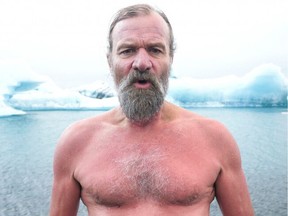Part of the problem in establishing a definitive position on the value of ice baths is that everyone’s response to cold is different.

Article content
Sitting in a tub full of ice water has long been used to aid recovery after a tough workout, often during a stretch of back-to-back games or competitions. It’s the promise of reduced muscular soreness that motivates most elite athletes to immerse their body in a bath cold enough to take their breath away.
Advertisement 2
Article content
But lately, claims that cold-water immersion is a cure-all for what ails you has made ice baths popular among the not so athletic. Enhanced fat loss, immunity, sleep and mood have all been linked to plunging into an environment we would otherwise avoid at all costs. Celebrities such as Harry Styles and Lizzo have bought into the therapeutic properties of ice baths. So has social media. But it’s the regular Joe and Jill lowering themselves into tubs of ice water that has revitalized a trend that has ebbed and flowed in popularity since the ancient Greeks. Cold plunge tubs can be found on Amazon, starting at about $100, and many a chest freezer has been refurbished to allow couples to plunge together.
Morgan Woodfine, from the Montreal suburb of Carignan, started cold plunging about six months ago. She took her first dip in a Toronto bathhouse that combines sauna, ice baths and breathwork to create a “new form of wellness entertainment.” The experience included 20 minutes in the sauna, a quick rinse and three minutes in an ice tub with a teacher leading the small group in breathwork and meditation.
Advertisement 3
Article content
“It was a whole vibe,” said Woodfine, who claimed it left her in a “happy place.”
When she got home, she repurposed a cattle tub as a plunge tub and started her own regimen of icy dips, roughly following a protocol outlined by Wim Hof, a Dutch extreme athlete who extols the virtues of revelling in the cold. But three minutes in the tub several times a week didn’t feel right, so Woodfine modified her routine, limiting her immersive experience to a couple times a week.
“I use it as an exciting way to wake myself up,” said Woodfine, who enjoys what she describes as an immediate boost to her physical and emotional well-being.
There’s no disputing that an ice bath is invigorating. The acute stress of cold water causes a release of mood-enhancing endorphins. But is the long list of therapeutic benefits currently linked to exposure to the cold overstated?
Advertisement 4
Article content
Nicholas Tiller thinks so. A senior researcher at the Institute of Respiratory Medicine and Exercise Physiology at Harbor-UCLA, he says there’s little in the way of evidence to support claims that ice baths have healing properties.
Even the science behind the benefits of ice baths on recovery is equivocal, with some studies suggesting cold-water immersion inhibits strength gains while others report enhanced recovery of muscular power (such as sprinting or jumping) 24 hours after high-intensity exercise. To further complicate matters, a 2022 study published in Sports Medicine advises that slightly warmer water and less time spent in the tub may actually be more beneficial to recovery, especially after endurance workouts.
Advertisement 5
Article content
Part of the problem in establishing a definitive position on the value of ice baths is that everyone’s response to cold is different, with age, gender, body composition, fitness and health all likely factors playing into how well the cold is tolerated. Then there are the various protocols, including how long and how much of the body is exposed to the cold and, of course, the temperature of the water.
For some, cold-water immersion is done in controlled circumstances with the water temperature, depth and length of the soak firmly regulated. Others jump in a lake, ocean or stream with the intent to stay as long as possible before hypothermia sets in.
Within the athletic milieu, the most popular post-workout protocol calls for a 10/10 approach: 10 minutes in 10 C water. Any longer than that, and instead of decreasing blood flow (and inflammation), the opposite occurs. Blood flow actually increases, which means any potential for enhanced recovery is likely reduced. Tiller also notes that ice baths haven’t proved to be any more effective than less extreme forms of post-exercise recovery, which begs the question of why athletes would choose such a harsh form of therapy.
Advertisement 6
Article content
It’s also important to note that exposure to extreme cold isn’t without risk. Plunging into cold water can leave you gasping for breath and make breathing uncomfortable. It can also cause a sharp spike in blood pressure that strains the heart and increases the risk of fainting, so you may want to think twice if you have pre-existing cardiac conditions.
Tiller admits there’s a lot about cold-water immersion we still don’t know, but what we do know is that ice baths aren’t a panacea for everything that hurts. Nor are they a shortcut to better mental health. That said, there’s no discounting the invigorating appeal of a short stint in cold water — and the discipline it takes to endure the discomfort, which may be a large part of its appeal.
“In a big world of chaos, it’s where I find some calm,” said Woodfine.
Fitness: Should we pour cold water on the idea of ice baths being a cure-all? - North Bay Nugget
Read More




No comments:
Post a Comment